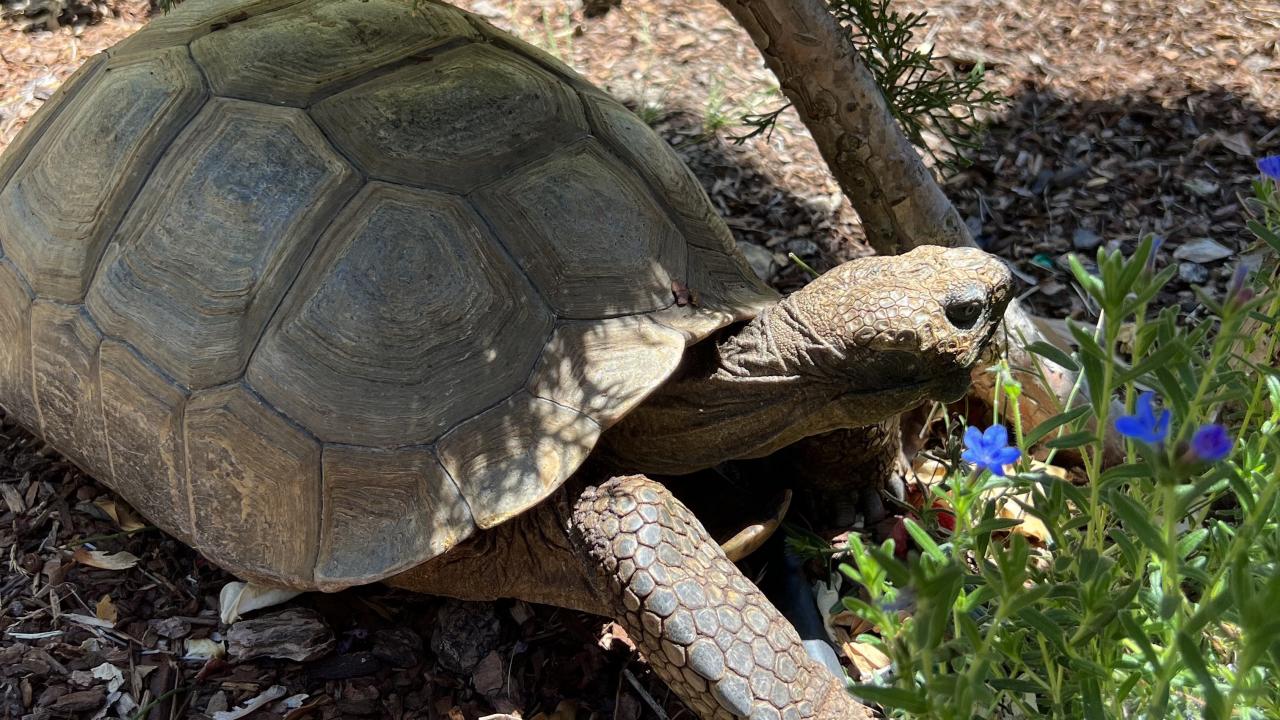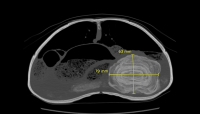
UC Davis Exotic Animal Specialists Treat 80-Year-Old Desert Tortoise
“Case of the Month” – April 2023
Tortie, an 80-year-old California desert tortoise, was reunited with an old family member in the past year, and that reunion may have saved his life. Growing up, Cal Dalrymple always had Tortie as a pet – his parents acquired him more than 60 years ago, before Cal was born. After Cal’s parents passed away recently, Tortie went to live with Cal and his wife Michelle. Being a new reptile owner, Michelle began researching tortoises and decided to schedule a wellness examination for Tortie before last winter’s hibernation season. After something troubling appeared on an x-ray at that wellness examination, Tortie was referred to the exotic companion animal specialists at the UC Davis veterinary hospital.

Tortie was diagnosed with a bladder stone about the size of an average human fist, quite large for a 12-pound tortoise. The stone needed to be surgically removed. There are two different approaches to accomplish the surgery. The first approach is referred to as a plastronotomy, an invasive cut through the bottom of the shell to reach and remove the stone. But Dr. David Guzman, chief of the Companion Exotic Animal Medicine and Surgery Service, and resident Dr. Mariana Sosa Higareda wanted to attempt a less invasive procedure. They proposed surgically entering Tortie’s body cavity through an area in front of his back leg (the prefemoral fossa), using endoscopy tools to access the bladder, break up the stone and remove it through that area. If the stone was not removed, it would continue to grow, causing further damage to Tortie’s vital organs.
“Tortie is a great example of the importance of annual wellness examinations,” said Dr. Guzman. “Thankfully, his owners chose to get a hibernation consultation, but the stone could have been identified even earlier with an annual examination, and that smaller stone could’ve been removed much easier.”

While the less invasive procedure has been available for more than a decade, this is the first opportunity Dr. Sosa Higareda had to perform one in her residency. The diverse caseload of the exotic animal service—and the UC Davis veterinary hospital in general—offers a plethora of species and diseases/illnesses/injuries for UC Davis residents to encounter, making their residency program not only the largest in the nation, but also the most unique.
“While this procedure is less invasive, it still presented some challenges,” said Dr. Sosa Higareda. “We needed to get good exposure to the bladder through such a small opening and also come up with techniques to break down such a large stone and remove the pieces.”
Following three hours of surgery, the massive stone was completely broken down and removed, confirmed by endoscopic examination and a post-operative x-ray. Since it was expected he would not eat on his own for some time following the surgery, a feeding tube was placed to help Tortie receive proper nourishment and hydration, as well as easily administer medication. The slower metabolism of reptiles makes them notorious for their slow recovery from anesthesia, and Tortie took nearly 24 hours to become fully awake. During that time, he was closely monitored in the hospital.

To the university’s knowledge, Tortie is the oldest veterinary patient to ever undergo surgery at UC Davis.
Tortie received recheck examinations at two weeks and six weeks post-surgery. He progressively improved throughout this time, and his feeding tube was able to be removed. His owners now report he has great energy and an increased appetite.
“It’s really a miracle what Dr. Sosa Higareda and the team were able to do,” stated Michelle. “They put so much effort and concern into Tortie’s care. I was so appreciative. Tortie is absolutely back to his old self. He eats well and is active every day. He even seems to have a slight spring in his step since the procedure.”
# # #
